Geotechnical and Structural Damage to the Built Environment of Thessaly Region, Greece, Caused by the 2023 Storm Daniel
Abstract
1. Introduction
2. Thessaly Region in Central Greece
3. Storm Daniel and Subsequent Flooding Phenomena
4. Damage to the Built Environment
4.1. Overview and Interactive Map
- the 4-day total precipitation data for the stations presented in Table 1;
- the major flooded areas, as approximated from satellite images on 10 September 2023;
- the rivers and streams mentioned throughout Section 4;
- the buildings mentioned in Section 4.2;
- the road bridges mentioned in Section 4.4;
- the historical bridges mentioned in Section 4.4;
- the pedestrian bridges mentioned in Section 4.4;
- some representative landslides described in Section 4.5.
4.2. Damage to Buildings
4.2.1. Overview of the Effects of Flooding on Buildings
4.2.2. Structural Damage to Buildings
- Partial or total collapses of buildings with load-bearing masonry walls made of brick, adobe or natural stone.
- Settlement and/or rotation of reinforced concrete buildings at their foundation level due to the significant erosion (scouring) of the underlying soil beneath the foundation. In most cases, the buildings were rotated at their foundations as rigid bodies.
- The first case was the partial collapse of a two-storey elderly care house located in the city of Volos, which was built next to Krafsidonas stream. Figure 10a shows part of the collapsed building (highlighted in a circle in Figure 10a), with the remaining debris sitting at the bottom of the formed stream. A truck can also be observed next to the debris.
- The second case (Figure 10b) refers to a two-storey house located in the village of Chorto, on the southeast side of Mt. Pelion. This house was built at the edge of a small river’s mouth, and as a result of the scouring phenomena at the foundation level, the house experienced partial settlement, leading to permanent, non-reversible deformations.
- Similarly, the third case (Figure 10c) refers to a three-storey residential building experiencing excessive differential settlement of the foundation. The location of this building was at the southern edge of Mt. Pelion, in Platania village.
- The fourth case, shown in Figure 10d, was a two-storey building with one basement which totally collapsed as a solid body. This collapse was again the result of the severe forces developed as a result of the flooded river next to it (Pamisos River). The extreme discharge in the river and its high-speed flow caused gradual degradation of the naturally formed soil embankments. Thus, in order to accommodate the extreme flow demands, the width of the river increased from 120.0 m to 220.0 m, as shown in Figure 11 (the collapsed structure has been marked with a circle). This building was located in Mouzaki town, which is on the west side of Thessaly Region, close to the city of Karditsa, approximately 120 km in a straight line from Mt. Pelion.
- Finally, the fifth case refers to a part of a residential building in the village of Chania on Mt. Pelion. Part of the basement of the building collapsed due to ground erosion beneath its foundation caused by water flowing with high speed in a nearby stream that crosses the village (Figure 12).
4.3. Damage to the Road Network
4.4. Damage to Bridges
4.4.1. Road Bridges
- Scour at the foundations of the piers, which led to settlements and/or rotations of the piers and, subsequently, movements of the deck or even partial collapses of the deck.
- Scour at the area around an abutment of the bridge, mainly in the form of breaching of the approach embankment. In some cases, the extent of this damage was so severe that it led to the abutment’s collapse, which in turn triggered the collapse of the supported deck section.
- Structural damage to the wing walls of the abutments of bridges due to soil erosion or scouring at the foundation level of such elements.
- Structural damage to the decks of bridges due to the accumulation of debris or due to impact from heavy rock blocks that were moving together with the extreme flow of major streams during the storm.
Scouring Phenomena at the Foundation of Bridge Piers
Scouring Phenomena at the Foundation of Bridge Abutments
Structural Damage on Bridge Decks from Rock Impacts
Damage to the Wing Walls of Bridges
4.4.2. Historical Bridges
4.4.3. Pedestrian Bridges
4.5. Landslides and Soil Erosion
4.6. Damage to Public Buildings, Technical Works, Other Infrastructure and Lifelines
4.6.1. Public Buildings and Technical Works
4.6.2. Railway Network
4.6.3. Other Infrastructure and Lifelines
5. Discussion and Conclusions
Author Contributions
Funding
Data Availability Statement
Acknowledgments
Conflicts of Interest
References
- Pescaroli, G.; Alexander, D. Critical infrastructure, panarchies and the vulnerability paths of cascading disasters. Nat. Hazards 2016, 82, 175–192. [Google Scholar] [CrossRef]
- Centre for Research on the Epidemiology of Disasters (CRED). EM-DAT—The International Disaster Database. Available online: https://public.emdat.be/ (accessed on 27 December 2024).
- Kirby, A.M.; Roca, M.; Kitchen, A.; Escarameia, M.; Chesterton, O.J. Manual on Scour at Bridges and Other Hydraulic Structures, 2nd ed.; CIRIA Report C742; CIRIA: London, UK, 2015. [Google Scholar]
- Zhang, X.; Song, J.; Peng, J.; Wu, J. Landslides-oriented urban disaster resilience assessment—A case study in Shen Zhen, China. Sci. Total Environ. 2019, 661, 95–106. [Google Scholar] [CrossRef] [PubMed]
- Argyroudis, S.A.; Mitoulis, S.A.; Winter, M.G.; Kaynia, A.M. Fragility of transport assets exposed to multiple hazards: State-of-the-art review toward infrastructural resilience. Reliab. Eng. Syst. Saf. 2019, 191, 106567. [Google Scholar] [CrossRef]
- Collings, J.; Steele, M.; Wilkes, D.; Ashurst, D.; Harvey, B. Investigation into Highway Bridge Damage and Failures During the November 2009 Cumbria Flood; Forensic Engineering: Informing the future with lessons from the past; ICE Publishing: London, UK, 2013. [Google Scholar]
- Zurich Insurance Group and JBA Trust. Flooding After Storm Desmond. 2015. Available online: https://zcralliance.org/resources/item/flooding-after-storm-desmond (accessed on 17 February 2025).
- Argyroudis, S.; Mitoulis, S.A.; Hofer, L.; Zanini, M.A.; Tubaldi, E.; Frangopol, D.M. Resilience assessment framework for critical infrastructure in a multi-hazard environment: Case study on transport assets. Sci. Total Environ. 2021, 714, 136854. [Google Scholar] [CrossRef] [PubMed]
- Lehmkuhl, F.; Schüttrumpf, H.; Schwarzbauer, J.; Brüll, C.; Dietze, M.; Letmathe, P.; Völker, C.; Hollert, H. Assessment of the 2021 summer flood in Central Europe. Environ. Sci. Eur. 2022, 34, 107. [Google Scholar] [CrossRef]
- Korswagen, P.A.; Harish, S.; Oetjen, J.; Wüthrich, D. Post-Flood Field Survey of the Ahr Valley (Germany): Building Damages and Hydraulic Aspects; Delft University of Technology: Delft, The Netherlands, 2022. [Google Scholar] [CrossRef]
- Lekkas, E.; Mavroulis, S.; Mavrouli, M.; Gogou, M. The late October 2024 Valencia (Spain) Extreme Weather Events and Floods. Newsletter of Environmental, Disaster and Crises Management Strategies. 2024. Available online: https://edcm.edu.gr/en/newsletter-en/newsletter-31-the-late-october-2024-valencia-spain-extreme-weather-events-and-floods-eng (accessed on 17 February 2025).
- Lekkas, E.; Nastos, P.; Cartalis, C.; Diakakis, M.; Gogou, M.; Mavroulis, S.; Spyrou, N.-I.; Kotsi, E.; Vassilakis, E.; Katsetsiadou, K.-N.; et al. Impact of Medicane “IANOS” (September 2020). Newsletter of Environmental, Disaster and Crises Management Strategies. 2020. Available online: https://edcm.edu.gr/images/docs/newsletters/Newsletter_20_2020_Ianos.pdf (accessed on 27 December 2024).
- Diakakis, M.; Mavroulis, S.; Filis, C.; Lozios, S.; Vassilakis, E.; Naoum, G.; Soukis, K.; Konsolaki, A.; Kotsi, E.; Theodorakatou, D.; et al. Impacts of Medicanes on Geomorphology and Infrastructure in the Eastern Mediterranean, the Case of Medicane Ianos and the Ionian Islands in Western Greece. Water 2023, 15, 1026. [Google Scholar] [CrossRef]
- Mavroulis, S.; Mavrouli, M.; Lekkas, E.; Tsakris, A. Impact of the September 2023 Storm Daniel and Subsequent Flooding in Thessaly (Greece) on the Natural and Built Environment and on Infectious Disease Emergence. Environments 2024, 11, 163. [Google Scholar] [CrossRef]
- Lekkas, E.; Diakakis, M.; Mavroulis, S.; Filis, C.; Bantekas, Y.; Gogou, M.; Katsetsiadou, K.-N.; Mavrouli, M.; Giannopoulos, V.; Sarantopoulou, A.; et al. The Early September 2023 Daniel Storm in Thessaly Region (Central Greece). Newsletter of Environmental, Disaster and Crises Management Strategies. 2024. Available online: https://edcm.edu.gr/images/docs/newsletters/Newsletter_30_2024_Daniel_Thessaly.pdf (accessed on 27 December 2024).
- Dimitriou, E.; Efstratiadis, A.; Zotou, I.; Papadopoulos, A.; Iliopoulou, T.; Sakki, G.-K.; Mazi, K.; Rozos, E.; Koukouvinos, A.; Koussis, A.D.; et al. Post-Analysis of Daniel Extreme Flood Event in Thessaly, Central Greece: Practical Lessons and the Value of State-of-the-Art Water-Monitoring Networks. Water 2024, 16, 980. [Google Scholar] [CrossRef]
- Koutsoyiannis, D.; Iliopoulou, T.; Koukouvinos, A.; Malamos, N.; Mamassis, N.; Dimitriadis, P.; Tepetidis, N.; Markantonis, D. Production of Maps with Updated Parameters of the Ombrian Curves at Country Level (Implementation of the EU Directive 2007/60/EC in Greece); Technical Report; Department of Water Resources and Environmental Engineering—National Technical University of Athens: Athens, Greece, 2023; Available online: https://www.itia.ntua.gr/2273/ (accessed on 28 December 2024).
- Kathimerini Newspaper. Available online: https://www.ekathimerini.com/economy/1260156/latest-storm-daniel-damage-estimate-reaches-e5-billion/2025 (accessed on 17 February 2025).
- Karatzetzou, A.; Stefanidis, S.; Stefanidou, S.; Tsinidis, G.; Pitilakis, D. Unified hazard models for risk assessment of transportation networks in a multi-hazard environment. Inter. J. Disaster Risk Red. 2022, 75, 102960. [Google Scholar] [CrossRef]
- Huang, Z.-K.; Zhang, D.; Pitilakis, K.; Tsinidis, G.; Huang, H.; Zhang, D.; Argyroudis, S. Resilience assessment of tunnels: Framework and application for tunnels in alluvial deposits exposed to seismic hazard. Soil Dyn. Earthq. Eng. 2022, 162, 107456. [Google Scholar] [CrossRef]
- Tsinidis, G.; Karatzetzou, A.; Stefanidou, S.; Markogiannaki, O. Developments in seismic vulnerability assessment of tunnels and underground structures. Geotechnics 2022, 2, 209–249. [Google Scholar] [CrossRef]

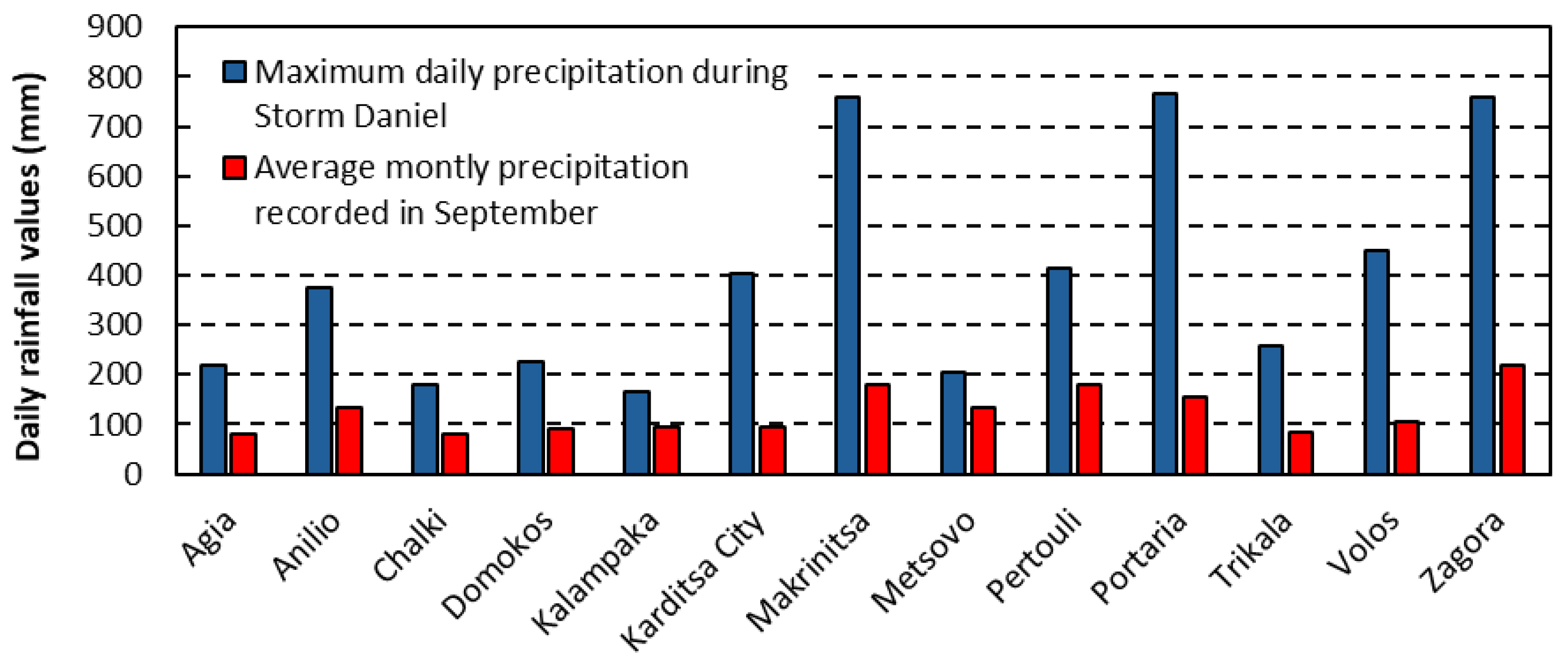


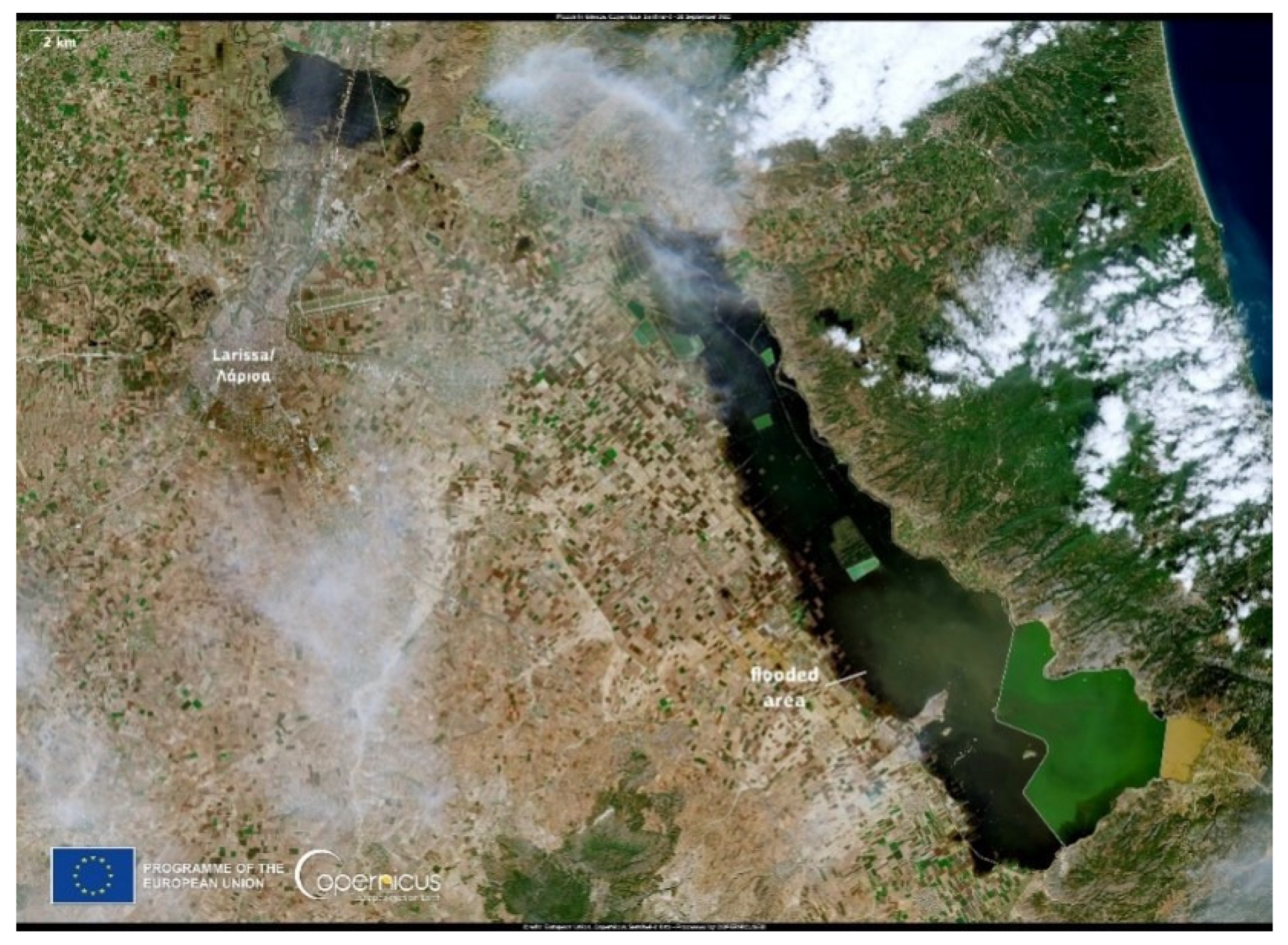


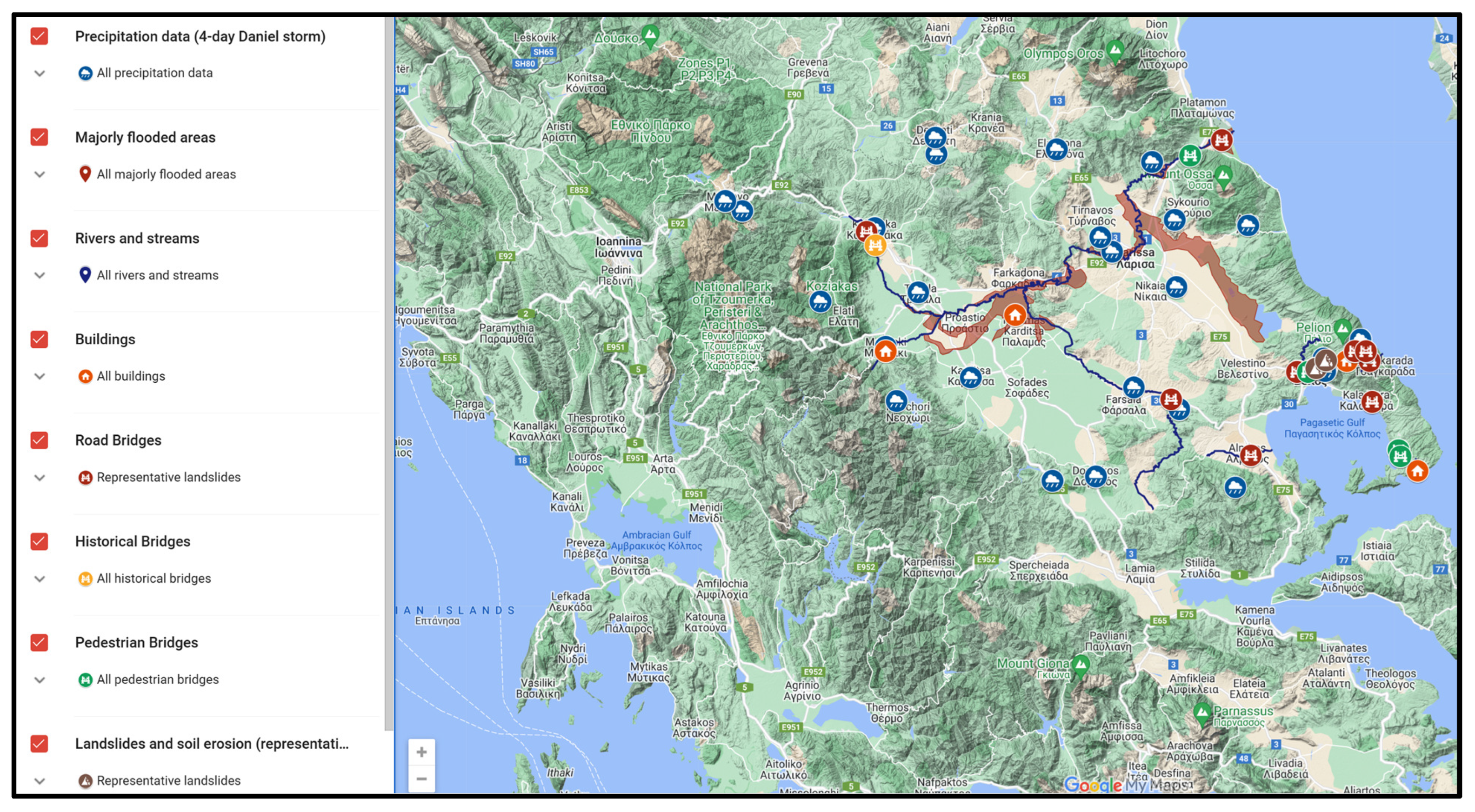
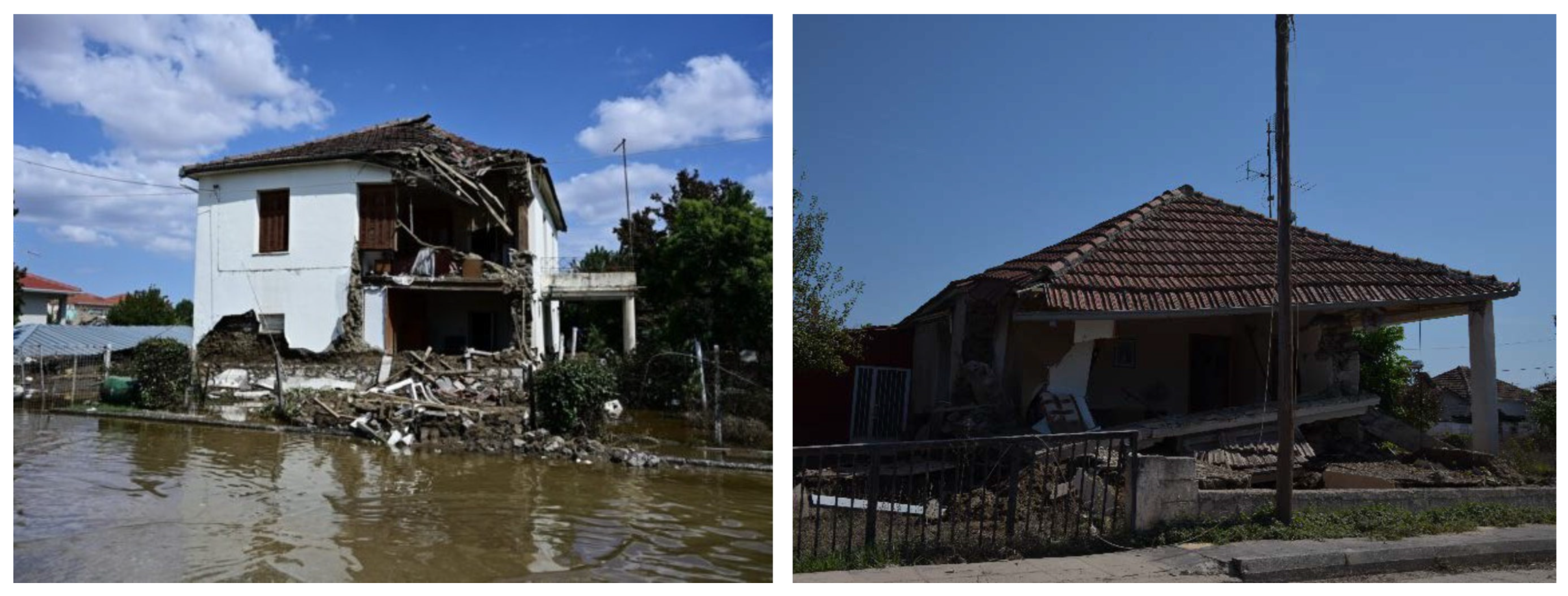
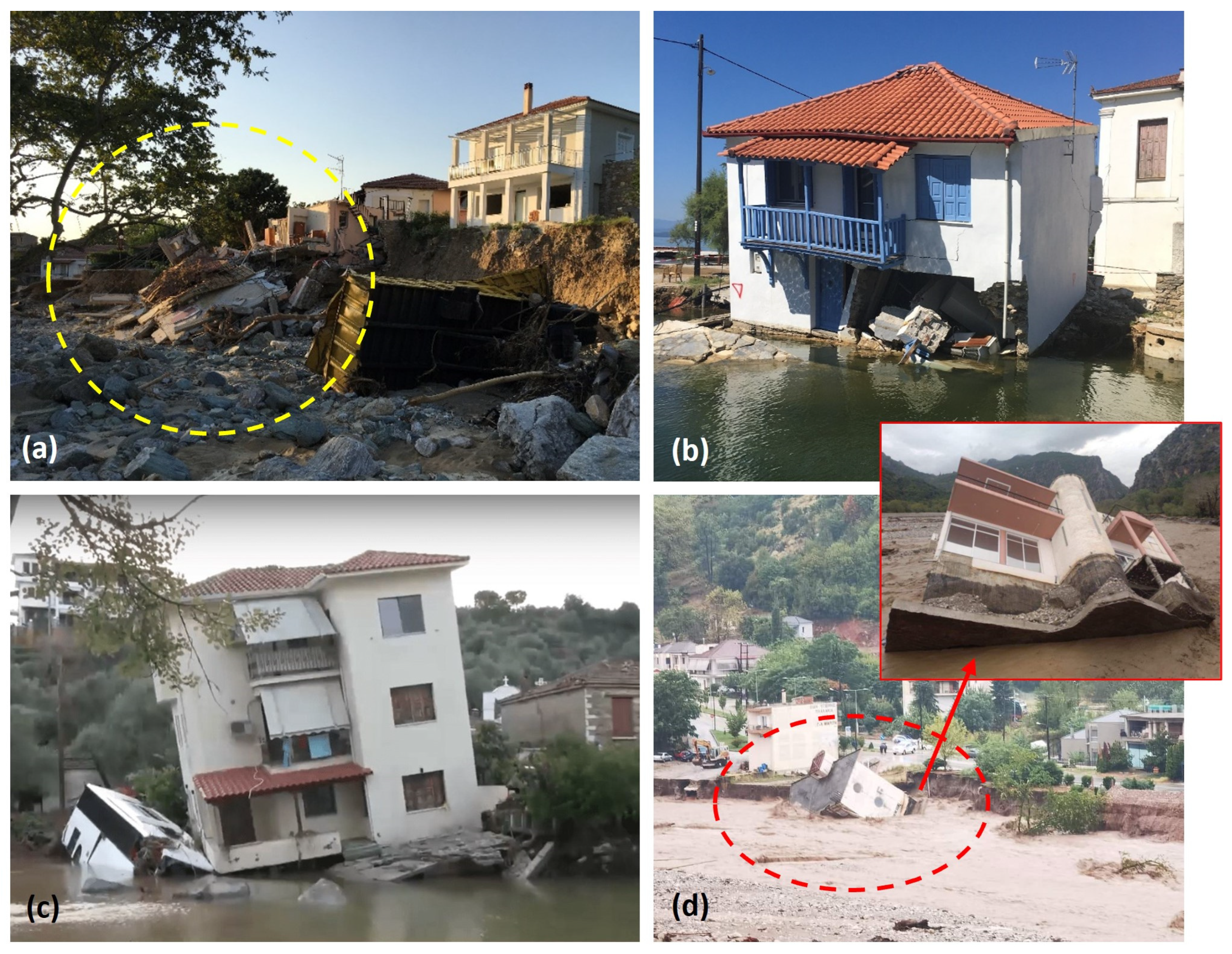



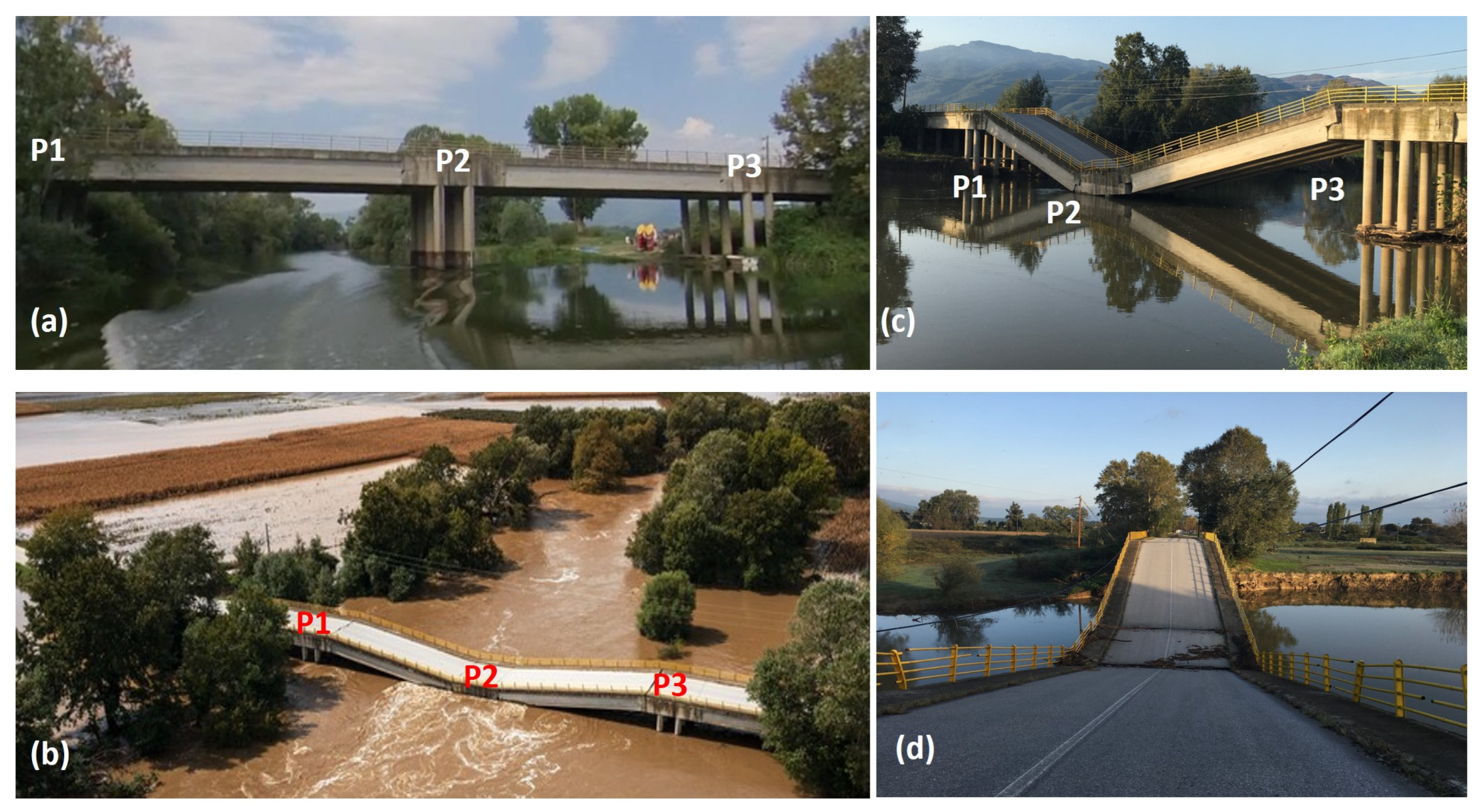

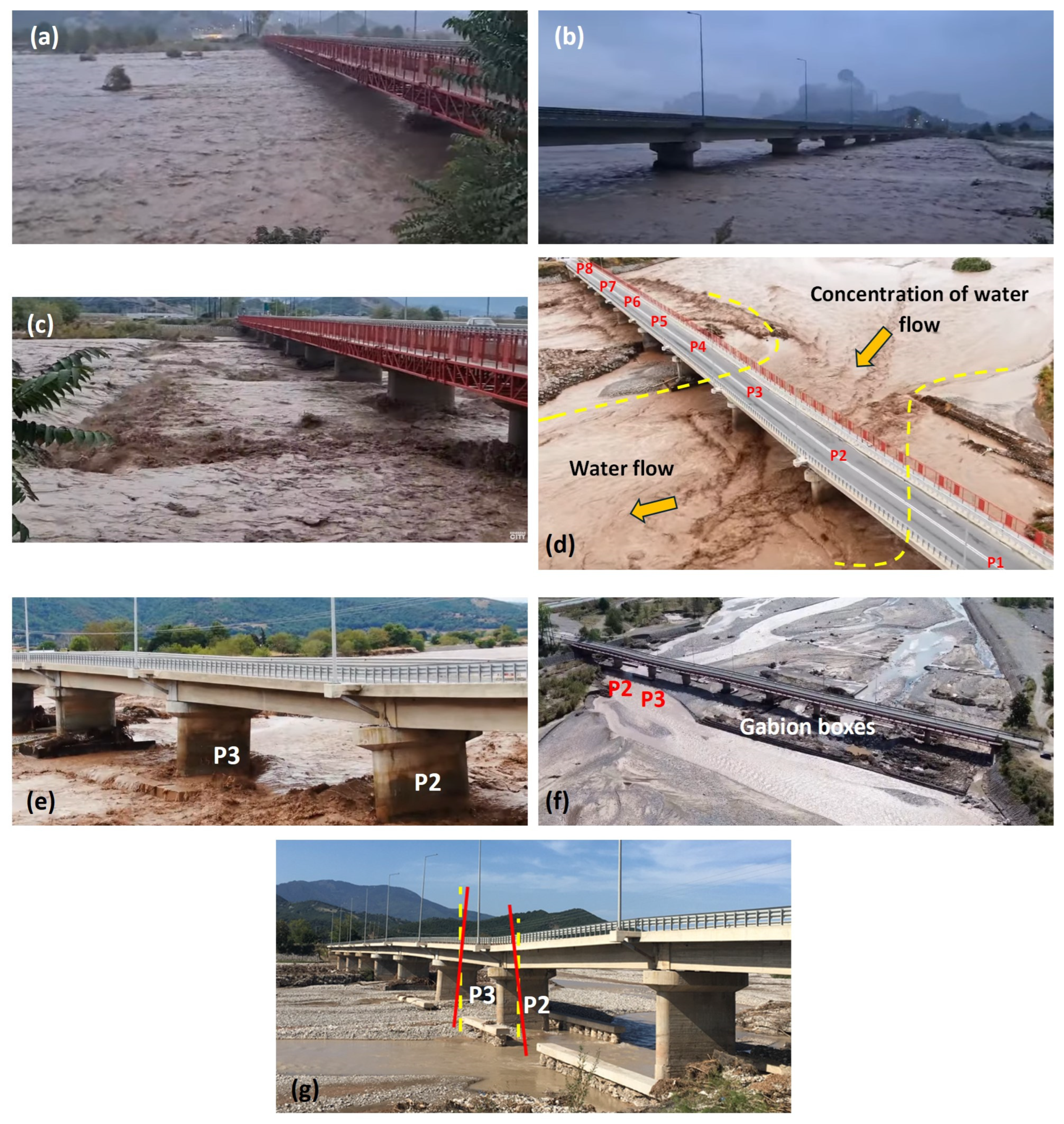

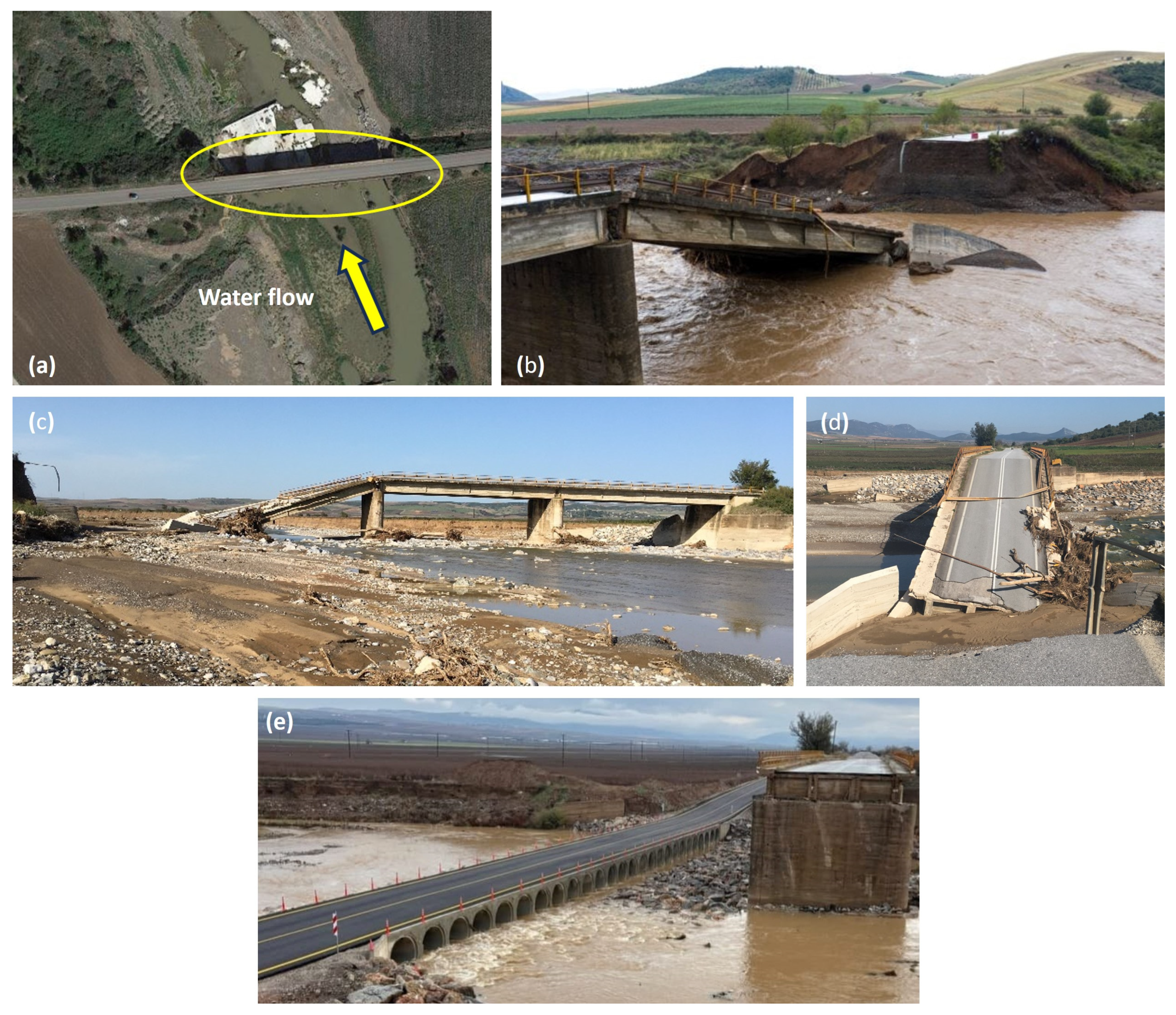
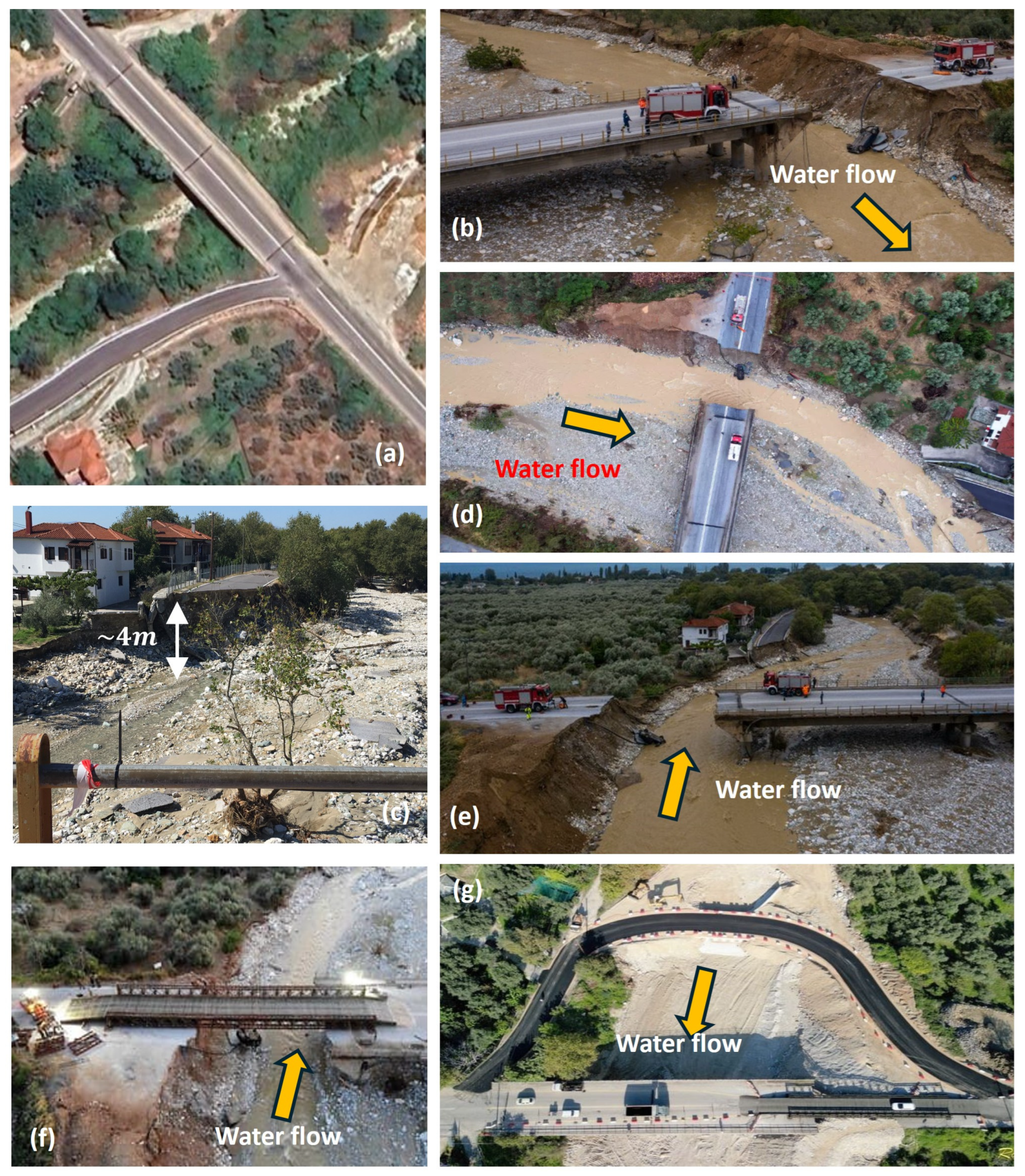
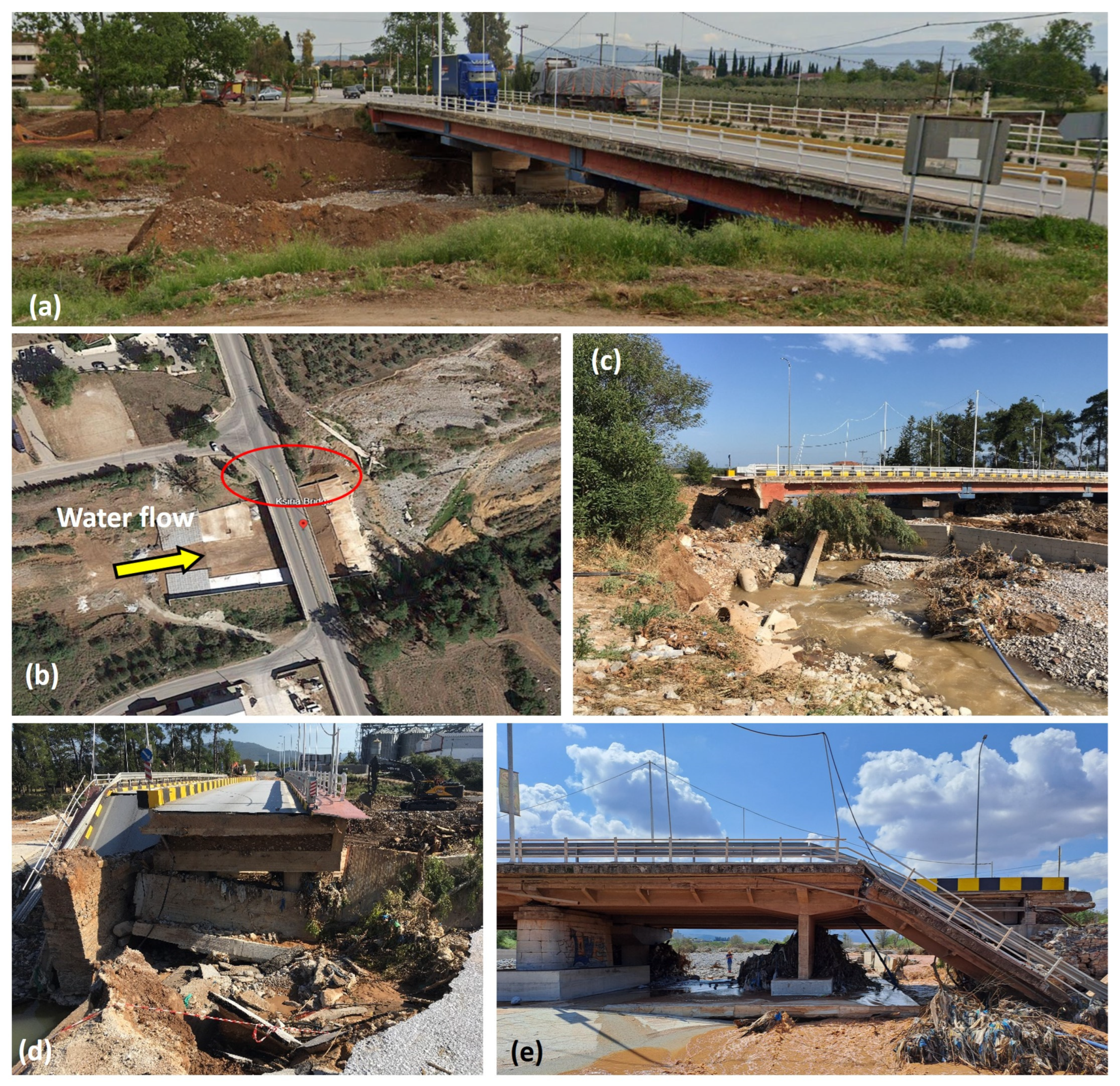
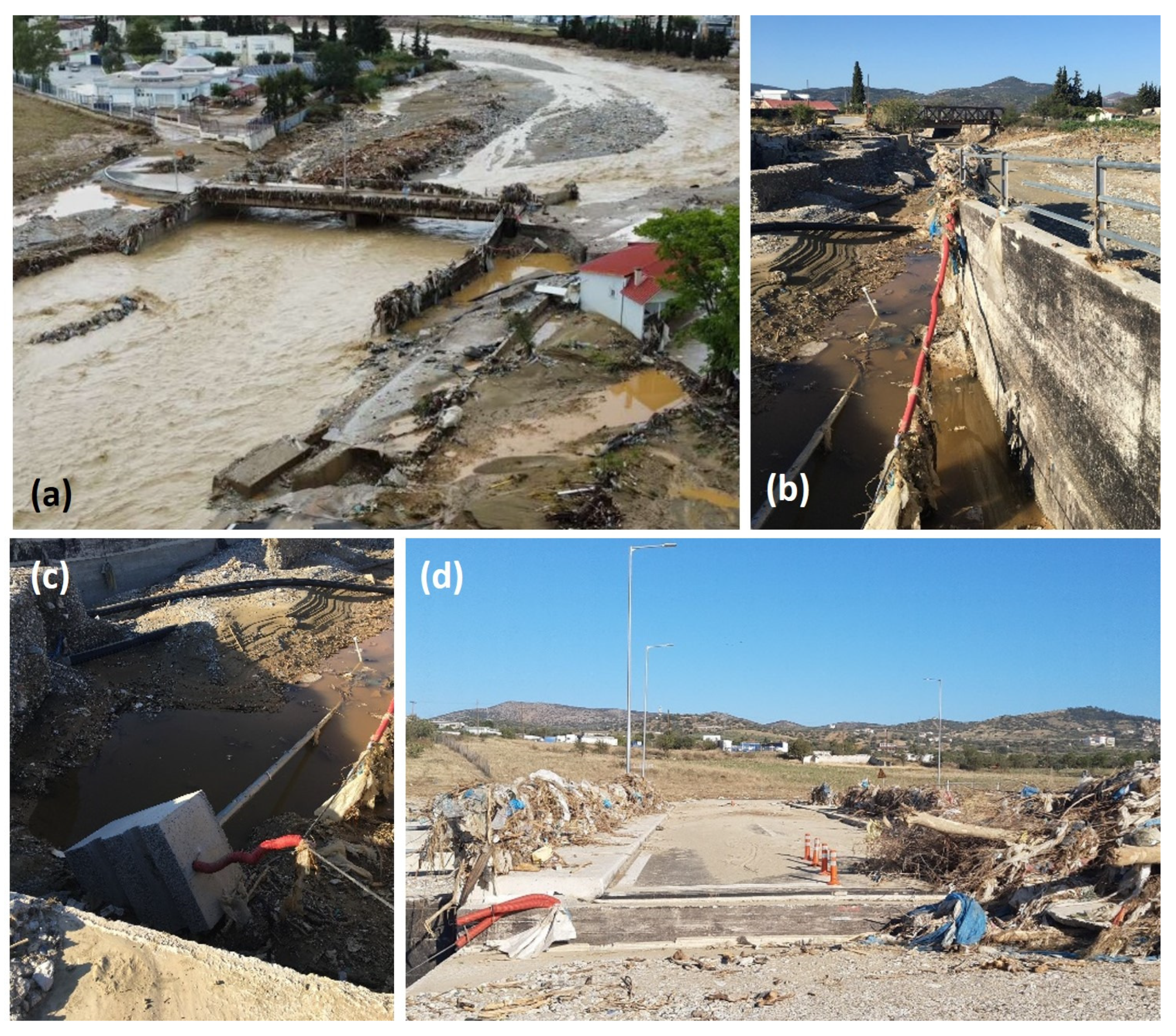
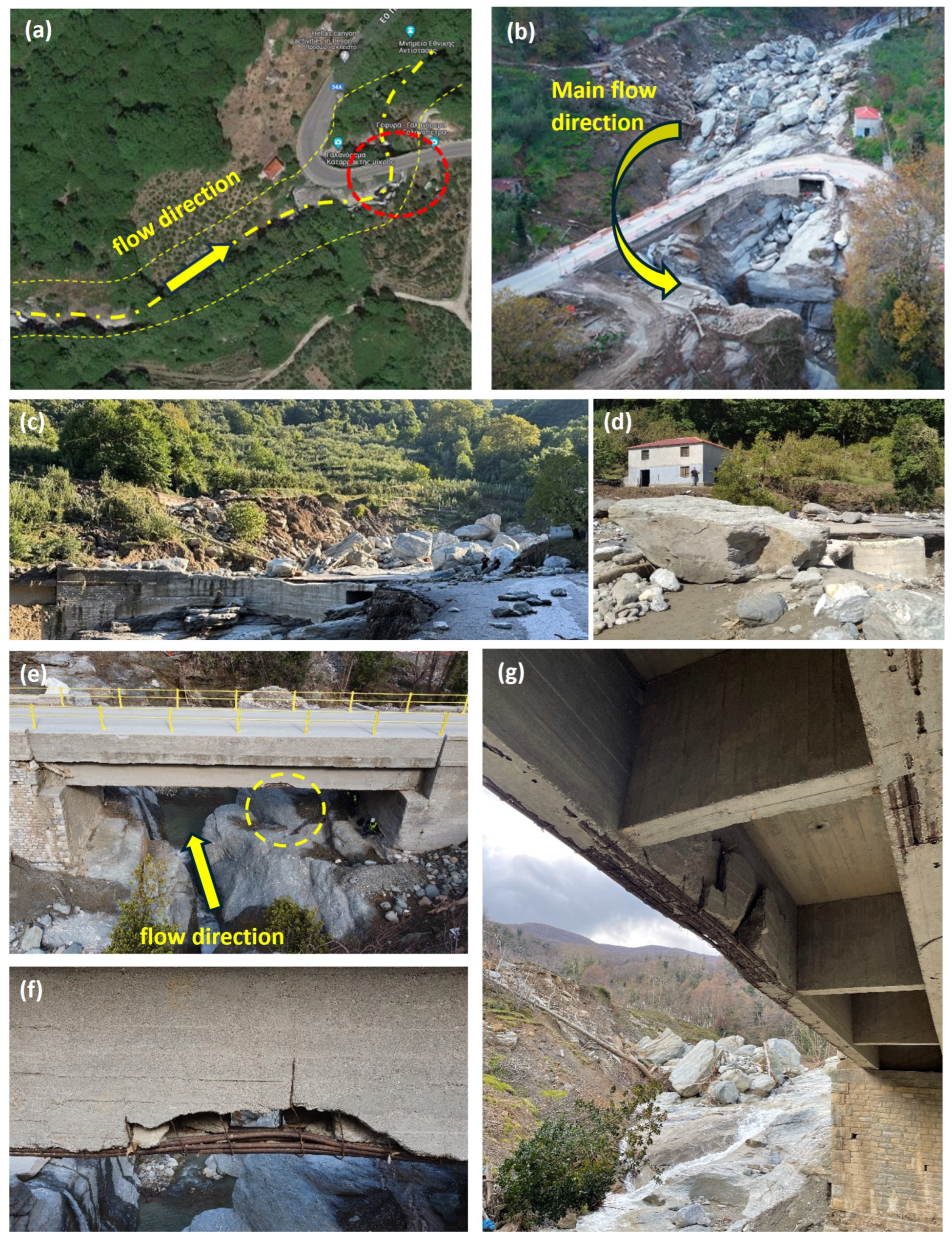
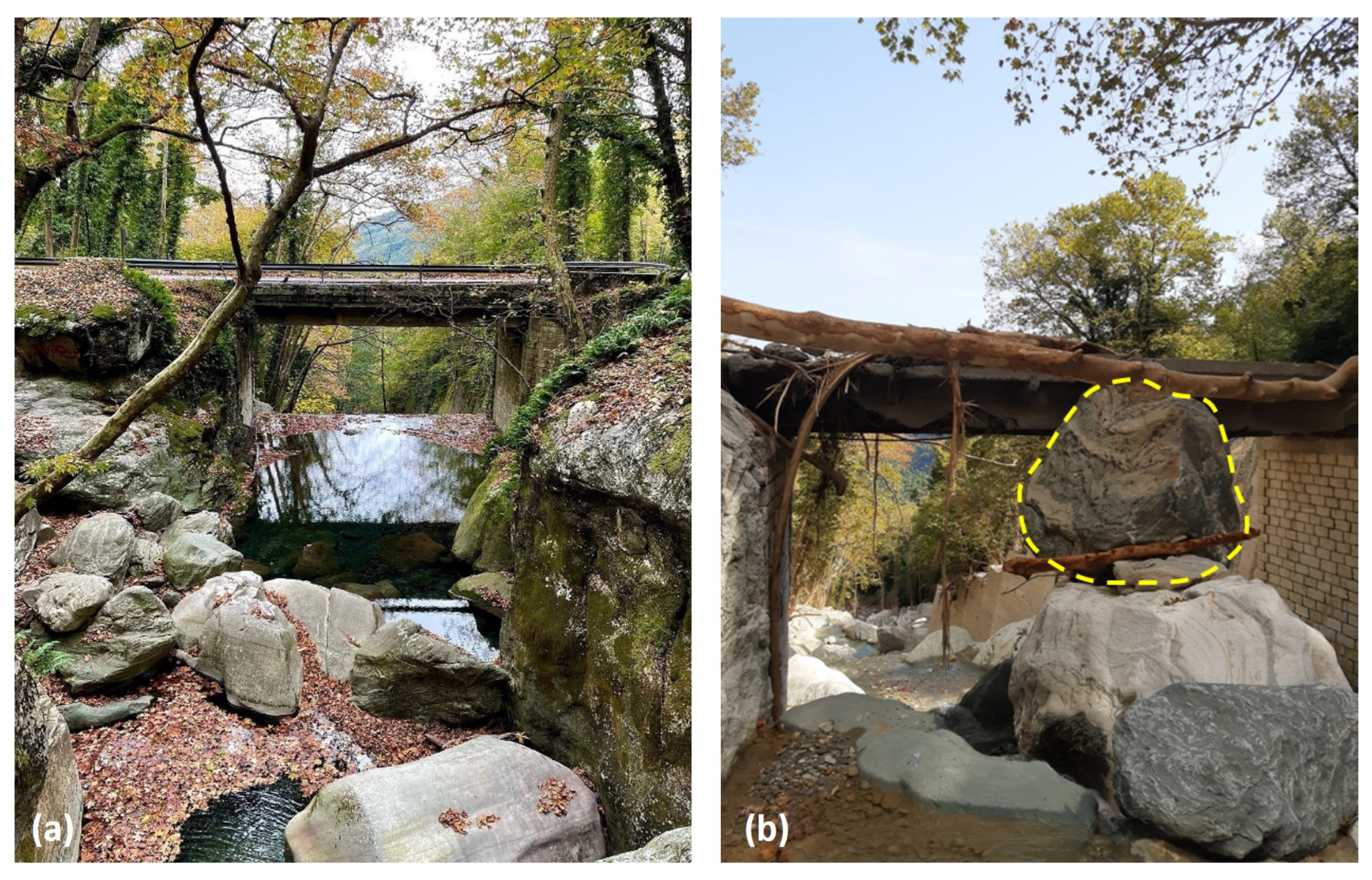











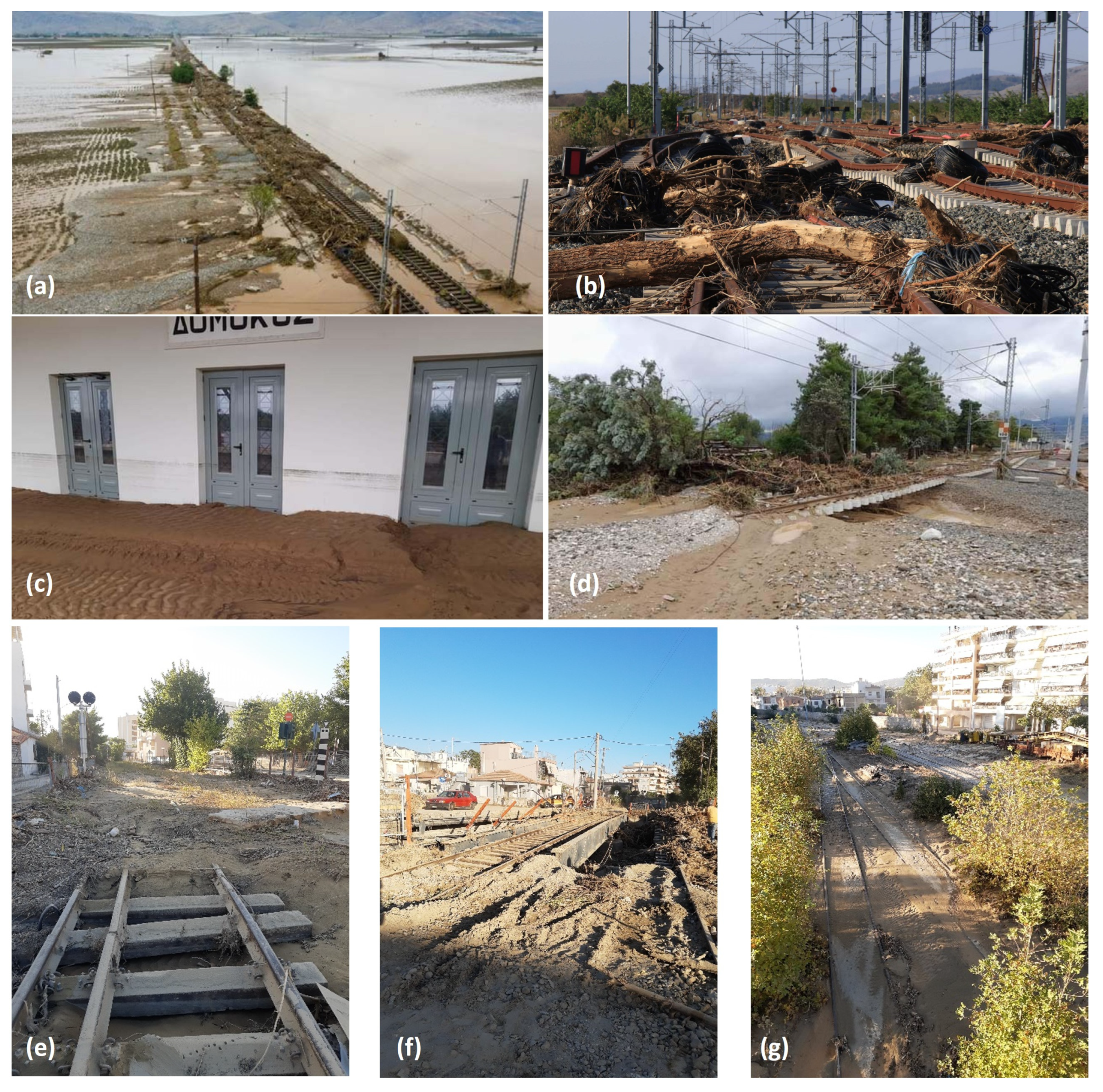
| Station | Latitude | Longitude | Altitude (m) | Owner | Rainfall Values (mm) | ||||
|---|---|---|---|---|---|---|---|---|---|
| 4-September | 5-September | 6-September | 7-September | Total | |||||
| Agia | 39.71615° N | 22.76201° E | 200 | NOA | 11.2 | 218.6 | 15.4 | 90.6 | 335.8 |
| Anilio | 39.74861° N | 21.22750° E | 1660 | NOA | 20.6 | 148.2 | 374.6 | 149.2 | 692.6 |
| Chalki | 39.57083° N | 22.54333° E | 75 | NOA | 25.2 | 180.8 | 68.8 | 30.4 | 305.2 |
| Dasochori | 39.88206° N | 21.81642° E | 737 | NOA | 13.8 | 98.6 | 46.4 | 23 | 181.8 |
| Dendra Tyrnavou | 39.65473° N | 22.34883° E | 75 | NOA | 19.2 | 86.4 | 64.8 | 22.8 | 193.2 |
| Deskati | 39.91978° N | 21.81449° E | 769 | NOA | 10.4 | 96 | 50.6 | 25.6 | 182.6 |
| Domokos | 39.12756° N | 22.30020° E | 570 | NOA | 40.4 | 110 | 225.2 | 6.4 | 382 |
| Elassona | 39.89276° N | 22.18080° E | 282 | NOA | 26.4 | 72.2 | 19.6 | 40.8 | 159 |
| Gonnoi | 39.86334° N | 22.46961° E | 111 | NOA | 14 | 147.4 | 31.4 | 71.2 | 264 |
| Kalampaka | 39.70899° N | 21.62846° E | 238 | NOA | 10.8 | 94.2 | 165.8 | 85.2 | 356 |
| Karditsa City | 39.36068° N | 21.92146° E | 121 | NOA | 42.4 | 185.2 | 404.4 | 26.8 | 658.8 |
| Kofoi | 39.10177° N | 22.72136° E | 500 | NOA | 23.4 | 152.6 | 342.2 | 32.2 | 550.4 |
| Makrinitsa | 39.40535° N | 22.98778° E | 850 | NOA | 125.2 | 757.4 | 273.6 | 79.2 | 1235.4 |
| Metsovo | 39.77162° N | 21.17698° E | 1240 | NOA | 20.2 | 91.8 | 204 | 75.8 | 391.8 |
| Mouzaki | 39.43115° N | 21.66175° E | 175 | NOA | 23.8 | 163.8 | 321.8 | 89 | 598.4 |
| Neraida | 39.28461° N | 22.55137° E | 243 | NOA | 19.6 | 226.6 | 91.2 | 23.8 | 361.2 |
| Nessonas | 39.72740° N | 22.53894° E | 92 | NOA | 11.6 | 78 | 3.6 | 71.6 | 164.8 |
| Pezoula | 39.30528° N | 21.69389° E | 891 | NOA | 43.2 | 250 | 378.4 | 90.8 | 762.4 |
| Platanoulia | 39.68859° N | 22.31356° E | 83 | NOA | 18.6 | 75.4 | 91.2 | 25.4 | 210.6 |
| Portaria | 39.38787° N | 22.99514° E | 600 | NOA | 105.4 | 764.7 | 14.4 | 0 | 884.5 |
| Smokovo | 39.11682° N | 22.16667° E | 444 | NOA | 40.2 | 97 | 89.4 | 14 | 240.6 |
| Trikala | 39.55857° N | 21.76247° E | 163 | NOA | 17.6 | 116.6 | 256.8 | 86.4 | 477.4 |
| Vamvakou | 39.33584° N | 22.41447° E | 148 | NOA | 19.4 | 191.4 | 129.8 | 29 | 369.6 |
| Volos | 39.37447° N | 22.99514° E | 52 | NOA | 35.2 | 450.8 | 121 | 10.4 | 617.4 |
| Zagora | 39.44820° N | 23.10069° E | 505 | NOA | 134.6 | 759.6 | 3.8 | 197.6 | 1095.6 |
| Station | T (Years) for: | Station | T (Years) for: | Station | T (Years) for: | ||||||
|---|---|---|---|---|---|---|---|---|---|---|---|
| 24 h | 48 h | 72 h | 24 h | 48 h | 72 h | 24 h | 48 h | 72 h | |||
| Agia | 55 | 24 | 23 | Georganades | 503 | 880 | 880 | Pezoula | 1794 | 1939 | 1279 |
| Anilio | 5043 | 5790 | 3944 | Gonnoi | 25 | 20 | 24 | Platanioula | 16 | 42 | 48 |
| Chalki | 361 | 417 | 401 | Kalampaka | 113 | 256 | 230 | Skopia | 9 | 7 | 10 |
| Dasochori | 13 | 13 | 12 | Karditsa City | 6354 | 6878 | 5816 | Smokovo | 15 | 41 | 40 |
| Dendra Tyrnavou | 16 | 35 | 42 | Makrinitsa | 6290 | 3724 | 2232 | Trikala | 1365 | 2448 | 2231 |
| Deskati | 11 | 11 | 10 | Mouzaki | 307 | 442 | 365 | Vamvakou | 270 | 410 | 380 |
| Domokos | 340 | 284 | 230 | Neraida | 463 | 374 | 278 | Volos | 1737 | 1497 | 1143 |
| Elassona | 6 | 6 | 8 | Nessonas | 9 | 6 | 11 | ||||
| Filiadona | 32 | 33 | 28 | Pertouli | 1904 | 1276 | 720 | ||||
| Region | Total Buildings | Total Inspections | Affected Buildings | ||||
|---|---|---|---|---|---|---|---|
| Affected | Not Affected | Residential Buildings | Business Premises | Public Buildings | Barns, Warehouses | ||
| Magnesia | 2718 | 2627 | 91 | 1921 | 123 | 14 | 569 |
| Karditsa | 3736 | 3449 | 253 | 2513 | 24 | 18 | 894 |
| Larissa | 3122 | 3097 | 25 | 2035 | 70 | 47 | 945 |
| Trikala | 3095 | 3062 | 32 | 2510 | 61 | 14 | 477 |
| Regional Unit | |||||
|---|---|---|---|---|---|
| Larisa | Magnesia | Trikala | Karditsa | Fthiotida | |
| Length of road network with reported damage (in km) | 11 | 13.3 | 11.7 | 22.3 | 11.9 |
| Number of damaged bridges (main bridges) | 5 | 14 | 35 | 21 | 4 |
Disclaimer/Publisher’s Note: The statements, opinions and data contained in all publications are solely those of the individual author(s) and contributor(s) and not of MDPI and/or the editor(s). MDPI and/or the editor(s) disclaim responsibility for any injury to people or property resulting from any ideas, methods, instructions or products referred to in the content. |
© 2025 by the authors. Licensee MDPI, Basel, Switzerland. This article is an open access article distributed under the terms and conditions of the Creative Commons Attribution (CC BY) license (https://creativecommons.org/licenses/by/4.0/).
Share and Cite
Tsinidis, G.; Koutas, L. Geotechnical and Structural Damage to the Built Environment of Thessaly Region, Greece, Caused by the 2023 Storm Daniel. Geotechnics 2025, 5, 16. https://doi.org/10.3390/geotechnics5010016
Tsinidis G, Koutas L. Geotechnical and Structural Damage to the Built Environment of Thessaly Region, Greece, Caused by the 2023 Storm Daniel. Geotechnics. 2025; 5(1):16. https://doi.org/10.3390/geotechnics5010016
Chicago/Turabian StyleTsinidis, Grigorios, and Lampros Koutas. 2025. "Geotechnical and Structural Damage to the Built Environment of Thessaly Region, Greece, Caused by the 2023 Storm Daniel" Geotechnics 5, no. 1: 16. https://doi.org/10.3390/geotechnics5010016
APA StyleTsinidis, G., & Koutas, L. (2025). Geotechnical and Structural Damage to the Built Environment of Thessaly Region, Greece, Caused by the 2023 Storm Daniel. Geotechnics, 5(1), 16. https://doi.org/10.3390/geotechnics5010016






